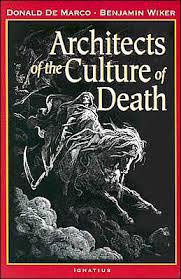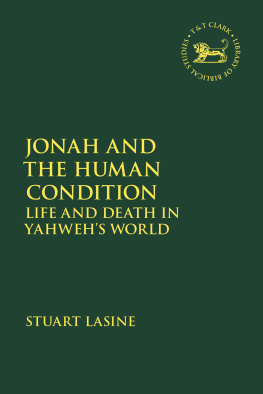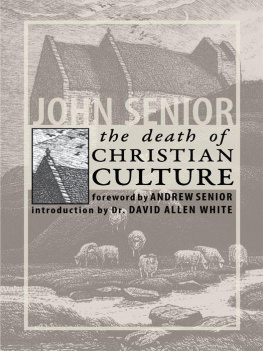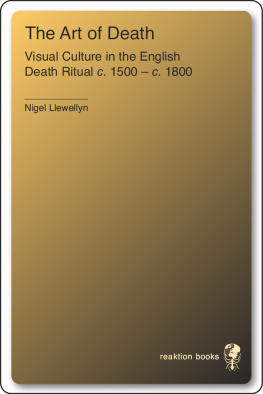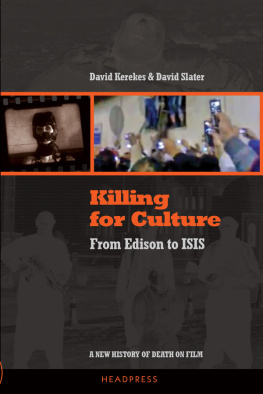ARCHITECTS OF THE CULTURE OF DEATH
DONALD DE MARCO
&
BENJAMIN D. WIKER
IGNATIUS PRESS
SAN FRANCISCO
This book expands on a series of articles previously published in
The National Catholic Register.
Reprinted by permission.
Cover art: Death on a Pale Horse
Engraving by Paul-Gustave Dor (1832-1883)
Bettmann/CORBIS
Cover design by Riz Boncan Marsella
2004 Ignatius Press, San Francisco
All rights reserved
ISBN 1-58617-016-3
Library of Congress Control Number 2003115835
Printed in the United States of America
This book is humbly dedicated to
Gerry Campbell and Floyd Centore,
both indomitable servants of the Culture of Life.
CONTENTS
FOREWORD
I don't know about you, but I love a suspense-filled action drama. When a writer can draw you into the war room of the enemy as they strategize waging a historic battle, and keep you on the edge of your seat, then you know that whatever happens, you will be grateful that he wrote the tale.
But this book is no tale! It is an all too true, action-packed, riveting, and educational expose. The cameo account about each of the architects of the Culture of Death reveals little-known facts that are shocking and incredible. As the reader moves from one personality to the next, a sordid philosophy unfolds, one that bears a striking resemblance to the invitation a certain viper extended to Eve in the Garden of Eden.
Recall that she was naive, but at the same time curious and prideful. When told she could be a god herself, she fell prey. Not much has changed since then, as this book makes perfectly clear.
Man's struggle to fend off the age-old temptation can be terribly difficult when the culture presents illusory images of what is true and what is not, such as the myths that women are actually in an equality competition with men, or that abortion is a mere personal choice, or that every human being is autonomous, disconnected from every other.
Who created these myths? In these pages you will find the answer, and you will not want to put the book down until you have mastered the art of seeing through the veil that has blinded so many of our fellow men. There is a single thread that ties each architect to the next; there is an artful mosaic dedicated to destroying reason, logic, and life.
The master-builders of the Culture of Death collaborated perhaps unwittinglyin creating an intricate game plan composed of half-truths, innuendo, and carefully placed academic fabrications craftily woven together and ensconced in a veneer of public relations finesse. Their individual salesmanship is second only to the gullibility of their audience and to the willing acceptance of their fare by the mainstream media.
Lest I give the plot away, I will close with a challenge to the reader: if you can finish reading this book and remain totally unchanged by what you learn, then you really didn't pay attention. Read it again.
Judie Brown
President American Life League Inc.
ACKNOWLEDGMENTS
I would like to thank Dave Pearson and the National Catholic Register for first printing shorter versions of some of these architects, and Don de Marco for his patience awaiting the book's completion. Even more, I would like to thank my dear wife, Teresa, who convinced me of the importance of this book and helped me see it through.
B.D.W.
I would like to thank Judie Brown for her enthusiastic support of this project and for graciously writing the introduction. Thanks are also warranted to the editors of Social Justice Review, Interim, Culture Wars, and Celebrate Life for their encouragement and for publishing articles based on some of the "architects", though not in the expanded forms in which they appear in this volume. Their permission for printing the versions contained herein is acknowledged and greatly appreciated.
D.D.M.
INTRODUCTION
Every building has an architect, someone who conceives the image of the edifice before it is built. If an entire culture is something constructed by human beings, then it also is based upon a particular design. Of course, in contrast to a single building, a culture is an ongoing work of far greater complexity and subtlety, and since the work stretches from decades into centuries, it has more than one architect. The many architects of a single, identifiable culture are those whose contributions to the overall plan are consistent with the original image.
An important example, of course, is Christian culture. The great image is, ultimately, given in the Person of Jesus Christ, understood as fully divine and fully human, and in the consequent doctrines that illuminate, legitimately develop, and safeguard this image. Christian culture, then, if it is truly Christian, will be built, both in its larger structure and in its finer details, according to this image.
The architects of Christian culture are nearly uncountable the Blessed Virgin Mary, St. Paul, St. Isidore, St. Cyprian, St. John Chrysostom, St. Augustine, St. Benedict, St. Leo, St. Francis, St. Dominic, St. Thomas Aquinas, and on through the rest of the saints; the bishops, who sat patiently and prayerfully through councils; the popes, who directed the Church through continual turbulence; the founders of religious orders; the eminent theologians; the great religious artists; the great religious writers, composers, and builders of churches; the great Christian lawmakers. All contributed to the ongoing effort to build and rebuild Christian culture.
Again, at the heart of this ongoing enterprise of culture building was the central guiding image of God become man, suffering and dying for each and every human soul, because each and every human being is made in the image of God and therefore of infinite worth in the eyes of the Creator. This God had purposely created the universe and given humanity an exalted place within it. But human rebellion unseated humanity from its rightful place, and the cure offered by God was effected through the mysterious drama of the Incarnation, death, and Resurrection of Jesus Christ. All true architects of Christian culture built according to the image of this great drama.
It is precisely because of the infinite value of each human person, as revealed especially in the great drama of Jesus Christ, that truly Christian culture must be a Culture of Life, a culture that sees the protection of persons and their moral, intellectual, and spiritual development as the defining goals of society. Whatever contradicts these goals can have no place in the Culture of Life.
Thus, in the Didache(TheTeaching of theTwelve Apostles), one of the earliest non-New Testament documents that has survived, we find a stark choice given those who would consider becoming Christians. The Didache was an initiation manual for converts, telling them what Christian holiness demanded and, consequently, what they must leave behind from the pagan culture. Its first words are, " There are two ways [or roads], one of life and one of death, but there is a great difference between the two ways."[1] Significantly, we find the following prohibitions among its admonitions:
You shall not kill. You shall not commit adultery. You shall not corrupt boys. You shall not commit fornication. You shall not steal. You shall not use magic. You shall not administer drugs [referring not only to "magic" potions, but especially to contraceptives/abortifacients].[2] You shall not slaughter a child in abortion, nor slay a begotten one. You shall not desire the goods of others.[3]
Looking over this list, it becomes quite clear that many of the pagan practices of Romethe very ones that the first converts to Christianity were called to reject as leading to the way of deathhave somehow, twenty centuries later, become part of contemporary culture again. Homosexuality, sex outside of marriage, interest in the occult, contraception, abortion, euthanasia, and infanticidewe have embraced all of them and even added incest and bestiality to the list.
Next page
